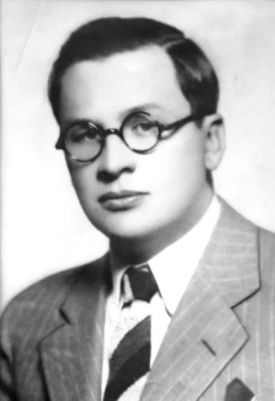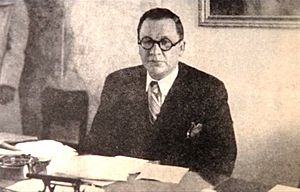Carlos Montenegro facts for kids
Quick facts for kids
Carlos Montenegro
|
|
|---|---|
 |
|
| Minister of Agriculture, Livestock, and Colonization |
|
| In office 20 December 1943 – 11 February 1944 |
|
| President | Gualberto Villarroel |
| Preceded by | Julio Céspedes Añez |
| Succeeded by | Rafael Otazo |
| Personal details | |
| Born |
Carlos Montenegro Quiroga
26 December 1903 Cochabamba, Bolivia |
| Died | 10 March 1953 (aged 49) New York City, New York, U.S. |
| Cause of death | Cardiac arrest |
| Political party | Revolutionary Nationalist Movement (1941–1953) |
| Other political affiliations |
Nationalist (1927–1936) United Socialist (1936–1941) |
| Spouses |
María Quiroga Vargas
(m. 1927; div. 1931)Yolanda Céspedes
(m. 1934) |
| Relations | Augusto Céspedes (brother-in-law) |
| Children |
|
| Parents | Rodolfo Montenegro Raquel Quiroga |
| Alma mater | Higher University of San Simón |
Carlos Montenegro Quiroga (born December 26, 1903 – died March 10, 1953) was an important Bolivian figure. He was a lawyer, journalist, politician, and writer. He served as the Minister of Agriculture for a short time from 1943 to 1944.
Carlos Montenegro was a main thinker for the Revolutionary Nationalist Movement (MNR) political party. He helped start the party's newspaper, La Calle, which shared the party's ideas. His most famous book, Nacionalismo y coloniaje (Nationalism and Colonialism), published in 1943, is about how journalism influenced Bolivia's history. It is considered one of the most important books in Bolivian history writing.
Contents
Early Life and Education
Carlos Montenegro was born in Cochabamba, Bolivia, on December 26, 1903. His father, Rodolfo Montenegro Guzmán, was a writer and politician. His mother, Raquel Quiroga, came from a family who owned a lot of land. Carlos was the second of five children. His family faced financial difficulties later on, losing some of their property.
When he was eighteen, Carlos started working in journalism. He wrote for a new and modern weekly magazine called Arte y Trabajo. This magazine, which started in 1921, discussed political issues. It promoted ideas like not being involved in politics, questioning religious authority, and free education. Carlos continued to work for Arte y Trabajo until 1929, even becoming its director for a time. In 1922, he was removed from the Catholic Church because of some of his strong opinions in his writings.
Carlos then studied law at the Higher University of San Simón. He became a lawyer in 1925. In 1927, he married María Quiroga Vargas, who was a poet, writer, and teacher. They had two children, Mario and Martha, but they divorced four years later.
Early Political Career
Carlos Montenegro started his political career in 1926. He worked as a local government official in Quillacollo. The next year, he joined the Nationalist Party of President Hernando Siles Reyes. Because he worked with President Siles, some student groups called him an "enemy of young people."
During the Chaco War
When the Chaco War began in 1932, Carlos Montenegro was 29 years old. He joined the army but didn't fight with weapons. Instead, he worked in the army's main office, helping with public information. During this time, he became friends with war reporter Augusto Céspedes. They both had similar political views and disliked the way things were run by the liberal government. In 1934, before the war ended, he left the army due to a stomach ulcer. He moved to La Paz, married Yolanda Céspedes (Augusto's sister), and started his own law firm.
The 1936 Coup
In 1936, Carlos Montenegro, along with Augusto Céspedes and Armando Arce, started a left-wing newspaper called La Calle. This newspaper was for the United Socialist Party (PSU), where Montenegro was the secretary-general. In May 1936, the PSU supported big national strikes against the government. Carlos Montenegro signed an agreement with the Workers' Federation of Labor. The next night, a "Revolutionary Committee" was formed, including Montenegro. This group took over several government buildings in La Paz and raised a red flag. This rebellion led to the military removing the conservative government of President José Luis Tejada Sorzano.
Diplomatic Work in Argentina
After the coup, Colonel David Toro became president. He saw Carlos Montenegro as a possible threat because Montenegro wanted more socialist policies than Toro could implement right away. To keep Montenegro away from politics in Bolivia, Toro sent him to Argentina. Carlos Montenegro became the secretary-general and counselor for the Bolivian team at the Chaco Peace Conference in Buenos Aires. He arrived in Argentina in December 1936 and stayed there for about two and a half years.
During his time in Argentina, Carlos Montenegro became part of the country's cultural scene. He met important people like diplomats, historians, and writers. His wife said that these famous people admired and respected Carlos for his intelligence and humor. Even when President Toro was overthrown and Montenegro's friend Germán Busch became president, others in the government made sure Montenegro stayed in Argentina. He eventually insisted on returning to Bolivia in late 1939.
Return to Bolivia and Later Years
When Carlos Montenegro returned to Bolivia in late 1939, he started a weekly newspaper called Busch. This newspaper, along with La Calle and Inti, helped challenge the views presented by newspapers controlled by the wealthy elite. Montenegro joined other young socialists, including Víctor Paz Estenssoro, Hernán Siles Zuazo, and Augusto Céspedes. Together, they formed a new political party in 1941, officially named the Revolutionary Nationalist Movement (MNR) in 1942.
The traditional political groups saw the MNR as a threat. In July 1941, President Enrique Peñaranda used a false report about a German plot to declare a state of emergency. This allowed the government to close the MNR newspapers and arrest important party members, including Montenegro. They were held in San Ignacio de Velasco for four months.
Villarroel Government
On December 20, 1943, President Peñaranda was removed from power by a military coup. This new government, led by Colonel Gualberto Villarroel, included Carlos Montenegro as the Minister of Agriculture. However, the United States did not recognize this new government because they thought the MNR was linked to fascism. To improve relations with the US, the Villarroel government removed Montenegro from his position on February 11, 1944. Later in 1944, Montenegro became the ambassador to Mexico. When the Villarroel government fell in 1946, Montenegro went back to Argentina for safety.
Final Years and Death
After six years living outside Bolivia, Carlos Montenegro returned with other MNR leaders after the Bolivian National Revolution. President Víctor Paz Estenssoro appointed him as ambassador to Chile, but Montenegro never took the job. Due to his poor health, he was admitted to a hospital in New York City. He passed away there on March 10, 1953, at the age of 49.
Publications
- ————————— (1943) (in es). Nacionalismo y coloniaje | su expresión histórica en la prensa de Bolivia. La Paz: Ediciones Autonomía. ISBN 978-99974-62-04-6. https://books.google.com/books?id=9ChxAAAAMAAJ.
|
See also
 In Spanish: Carlos Montenegro para niños
In Spanish: Carlos Montenegro para niños



